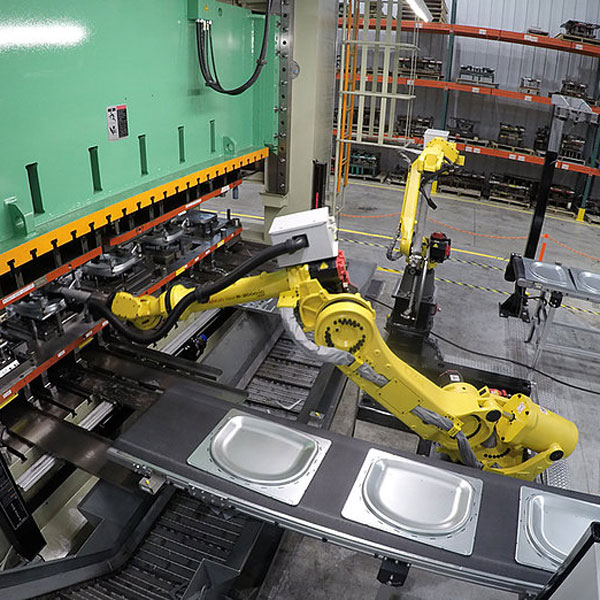Steel Marking Developments: Elevating Manufacturing Processes for Superior Outcomes
In the realm of manufacturing processes, steel marking has long been a foundation method for producing a selection of accuracy elements. With the ruthless march of technological advancement, the landscape of metal marking is going through a considerable change. Developments in this area are not just improving the effectiveness and quality of production but are additionally paving the way for new possibilities that were formerly past reach. As the sector accepts these sophisticated growths, a redefinition of what is possible in production is underway, appealing premium outcomes and setting new requirements for excellence in the area.
Development of Steel Marking Techniques

In addition, advancements in product science have caused the advancement of high-strength alloys that can currently be effortlessly stamped right into complex forms, catering to a more comprehensive series of industrial applications. The combination of robotics and man-made knowledge has actually better enhanced the stamping procedure by enhancing rate and precision while reducing the risk of human error.

Effect of Advanced Materials
Have sophisticated materials transformed metal stamping procedures considerably in the production industry? By using materials such as high-strength alloys, progressed compounds, and ingenious coatings, metal stamping processes can now create parts that are lighter, stronger, and much more durable than ever previously.
These sophisticated products supply remarkable mechanical residential or commercial properties, deterioration resistance, and thermal security, permitting manufacturers to meet the needs of contemporary markets such as aerospace, automobile, and electronic devices. Furthermore, using sophisticated products in steel marking has actually helped with the manufacturing of complicated geometries and intricate styles that were previously unattainable via standard methods.
Moreover, the application of innovative products has actually resulted in reduced material waste, reduced production expenses, and much shorter preparations, making steel marking processes extra sustainable and economical. As technology remains to breakthrough, the impact of innovative products on metal stamping procedures is expected to drive additional development and boost the competitiveness of makers in the worldwide market.
Automation in Steel Stamping
The advancement of steel marking procedures driven by the integration of advanced materials has actually set the phase for substantial advancements in automation within the manufacturing market. Automation in metal marking has actually reinvented production procedures, enhancing effectiveness, precision, and general result high quality. Through the utilization of robotics, sensing units, and computer-controlled systems, tasks that were taxing and when hands-on can currently be performed with exceptional rate and precision.
Automation in metal marking not just increases manufacturing prices but likewise ensures consistency in the manufacturing process. By minimizing human treatment, the threat of mistakes is significantly minimized, leading to greater degrees of item harmony and integrity. Furthermore, automation allows suppliers to carry out complex marking jobs that would certainly be difficult or impractical to accomplish manually.
Furthermore, automation in metal marking adds to a safer working setting by lowering the demand for employees to participate in hazardous or recurring jobs - Metal Stamping. This shift in the direction of automation not just improves efficiency however likewise leads the way for the future of production, where innovation plays a central function in driving functional excellence
Quality Control and Assessment Solutions
With a concentrate on accuracy and integrity, quality assurance and inspection systems play a crucial role in guaranteeing product quality in steel marking procedures. These systems are designed to check every phase of manufacturing, from product examination to the end product, to ensure that all elements fulfill the needed standards. By applying innovative modern technologies such as optical evaluation systems, coordinate determining machines (CMM), and automated evaluating why not try these outHome Page tools, producers can spot also the smallest discrepancies in measurements, surface high quality, and general honesty of stamped components.

Sustainability Practices in Metal Stamping
Structure upon the structure of precision and integrity established through quality control and evaluation systems, the combination of sustainable techniques in steel marking processes is progressively coming to be a focal factor for makers seeking to minimize environmental impact and enhance source usage. Sustainability methods in metal stamping include an array of initiatives targeted at lowering waste generation, power intake, and greenhouse gas exhausts throughout the production process.
One key aspect of sustainability in steel marking is the fostering of environment-friendly materials and modern technologies that advertise recyclability and waste decrease. By using recycled products and applying energy-efficient machinery, suppliers can decrease their carbon footprint and contribute to an extra sustainable production cycle. Additionally, enhancing production processes to decrease material waste and energy usage not just benefits the environment but also brings about set you back savings for services over time.
Moreover, the application of sustainable methods in steel stamping can improve brand credibility and attract eco mindful customers. As sustainability remains to obtain significance in the manufacturing market, integrating green campaigns right into metal stamping procedures is essential for lasting success and competitiveness out there.
Verdict
To conclude, steel marking methods have dramatically developed with time, including advanced products and automation to enhance manufacturing procedures. find out Quality control and assessment systems play an essential role in guaranteeing exceptional results, while sustainability methods are significantly being carried out to decrease environmental impact. These developments in metal marking have actually reinvented the market, bring about more reliable and lasting production techniques for numerous sectors.
Steel marking, when a handbook and labor-intensive procedure, has changed right into a very automated and innovative technique of shaping steel sheets right into different types and layouts.Have innovative products transformed metal stamping procedures significantly in the production sector? By utilizing materials such as high-strength alloys, progressed composites, and ingenious coatings, metal marking procedures can currently generate components that are lighter, stronger, and more durable than ever previously.
The evolution of metal stamping procedures driven by the assimilation of advanced materials has actually established the phase for considerable developments in automation within the production industry.In conclusion, steel marking methods have actually considerably developed over time, incorporating advanced materials and automation to improve manufacturing processes.